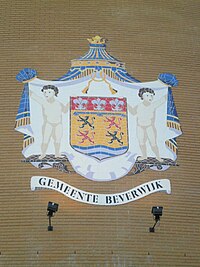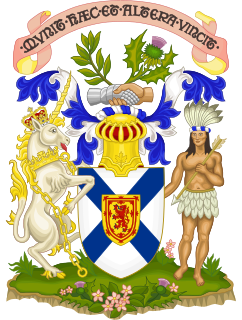
The coat of arms of Nova Scotia is the heraldic symbol representing the Canadian province of Nova Scotia. It is the oldest provincial achievement of arms in Canada, and the oldest British coat of arms in use outside Great Britain. It is blazoned as follows: Argent, a saltire azure charged with an escutcheon of the Royal Arms of Scotland.
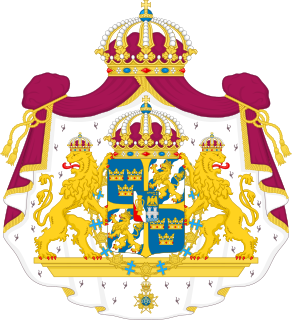
The coat of arms of the Kingdom of Sweden has a greater and a lesser version.

The coat of arms of Quebec was adopted by order-in-council of the Government of Quebec on 9 December 1939, replacing the arms assigned by royal warrant of Queen Victoria on 26 May 1868.

In heraldry, an ordinary is a simple geometrical figure, bounded by straight lines and running from side to side or top to bottom of the shield. There are also some geometric charges known as subordinaries, which have been given lesser status by some heraldic writers, though most have been in use as long as the traditional ordinaries. Diminutives of ordinaries and some subordinaries are charges of the same shape, though thinner. Most of the ordinaries are theoretically said to occupy one-third of the shield; but this is rarely observed in practice, except when the ordinary is the only charge.

The coat of arms of North Dakota was created for use by the state government and National Guard units. An image of the coat of arms is seen on the flag of the Governor of North Dakota and a short discussion of its use can be found at the North Dakota state government website.

The coat of arms of the Kingdom of the Netherlands was originally adopted in 1815 and later modified in 1907. The arms are a composite of the arms of the former Dutch Republic and the arms of the House of Nassau, it features a checkered shield with a lion grasping a sword in one hand and a bundle of arrows in the other and is the heraldic symbol of the monarch and the country. The monarch uses a version of the arms with a mantle while the government of the Netherlands uses a smaller version without the mantle (cloak) or the pavilion, sometimes only the shield and crown are used. The components of the coats of arms were regulated by Queen Wilhelmina in a royal decree of 10 July 1907, affirmed by Queen Juliana in a royal decree of 23 April 1980.

The coat of arms of Luxembourg has its origins in the Middle Ages and was derived from the arms of the Duchy of Limburg, in modern-day Belgium and the Netherlands. In heraldic language, the arms are described as: Barry of ten Argent and Azure, a Lion rampant queue forchée Gules crowned, armed and langued Or.
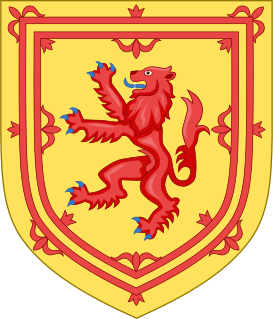
The royal arms of Scotland is the official coat of arms of the King of Scots first adopted in the 12th century. With the Union of the Crowns in 1603, James VI inherited the thrones of England and Ireland and thus his arms in Scotland were now quartered with the arms of England with an additional quarter for Ireland also added. Though the kingdoms of England and Scotland would share the same monarch, the distinction in heraldry used in both kingdoms was maintained. When the kingdoms of Scotland and England were united under the Acts of Union 1707 to form the Kingdom of Great Britain, no single arms were created, thereby maintaining the convention that the royal arms used in Scotland would continue to differ from those used elsewhere.

The coat of arms of the Cape Colony was the official heraldic symbol of the Cape Colony as a British colony from 1875 to 1910, and as a province of South Africa from 1910 to 1994.
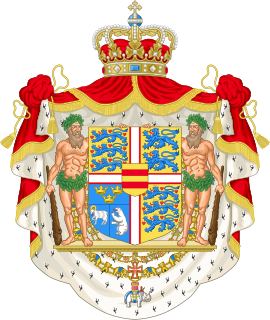
The coat of arms of Denmark has a lesser and a greater version.

The coat of arms of Alabama depicts a shield upon which is carried the symbols of the five states which have at various times held sovereignty over a part or the whole of what is now Alabama. These are the ancient coat of arms of France, the ancient coat of arms of Crown of Castile for Spain, the modern Union Jack of the United Kingdom and the battle flag of the Confederate States of America. On an escutcheon of pretence is borne the shield of the United States. The crest of the coat represents a ship which brought the French colonists who established the first permanent European settlements in the territory. Below is the state motto: Audemus jura nostra defendere, meaning "We dare defend our rights."

Portuguese heraldry encompasses the modern and historic traditions of heraldry in Portugal and the Portuguese Empire. Portuguese heraldry is part of the larger Iberian tradition of heraldry, one of the major schools of heraldic tradition, and grants coats of arms to individuals, cities, Portuguese colonies, and other institutions. Heraldry has been practiced in Portugal at least since the 11th century, however it only became standardized and popularized in the 16th century, during the reign of King Manuel I of Portugal, who created the first heraldic ordinances in the country. Like in other Iberian heraldic traditions, the use of quartering and augmentations of honor is highly representative of Portuguese heraldry, but unlike in any other Iberian traditions, the use of heraldic crests is highly popular.

The American College of Heraldry and Arms, Inc. was an American organization established in 1966 to promote heraldry in the United States. The corporate address of the college was Harbormaster's Building, Herald's Mews on Longneck, Pier 4 Pratt Street, Baltimore, Maryland.

The coat of arms of Cape Town is the traditional symbol of the municipality of Cape Town. The original arms from the 20th century are no longer in official use, though no new arms have yet been adopted.

In heraldry and heraldic vexillology, a blazon is a formal description of a coat of arms, flag or similar emblem, from which the reader can reconstruct the appropriate image. The verb to blazon means to create such a description. The visual depiction of a coat of arms or flag has traditionally had considerable latitude in design, but a verbal blazon specifies the essentially distinctive elements. A coat of arms or flag is therefore primarily defined not by a picture but rather by the wording of its blazon. Blazon is also the specialized language in which a blazon is written, and, as a verb, the act of writing such a description. Blazonry is the art, craft or practice of creating a blazon. The language employed in blazonry has its own vocabulary, grammar and syntax, which becomes essential for comprehension when blazoning a complex coat of arms.

The coat of arms of the Extremadura is described in the Title I of the Spanish Law 4 of June 3, 1985, the Law of the coat of arms, flag and regional day of Extremadura.
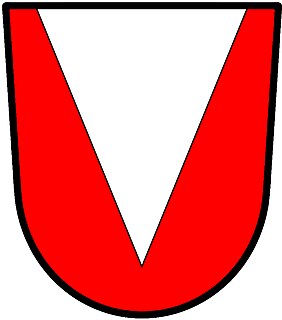
In heraldry, a pile is a charge usually counted as one of the ordinaries. It consists of a wedge emerging from the upper edge of the shield and converging to a point near the base. If it touches the base, it is blazoned throughout.
Liechtenstein heraldry is the form of heraldic art found in the country of Liechtenstein. It does not have a heraldic body of its own, relying on primarily German influences through the ruling house. It follows the German-Nordic tradition.
Coats of arms and seals of the County and Duchy of Cornwall, the Diocese of Truro, and of Cornish boroughs and towns.

The coat of arms of Bellingwedde is an official symbol of the municipality of Bellingwedde in the province of Groningen in the Netherlands. It was officially adopted in 1969. The coat of arms consists of a crowned shield with blue, gold, and silver elements, which refer to the abbey Palmar and the Wedderborg.

